I have always regarded this plant as a mountain dweller, as I first fell in love with it in the Drakensberg mountains in KwaZulu-Natal.
In the wild it is found on rocky cliffs and mountain slopes, but it also does well in inland gardens in a sunny spot with well-drained soil. Even in the garden, this small tree retains its characteristic gnarled appearance.
I first knew it by the common name Natal Bottlebrush (now the Glossy Bottlebrush), but although endemic to southern Africa, it also grows naturally outside Natal too, in the Eastern Cape and parts of the Free State, Lesotho and Swaziland.
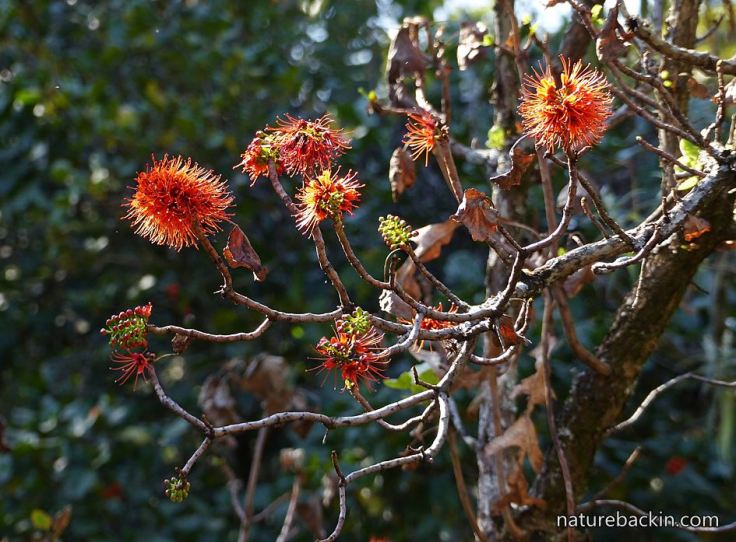
The Greyia sutherlandii in our garden comes into flower in July towards the end of winter when the tree is still bare and the garden still dry, ahead of its flush of new leaves signalling spring
When I first took an interest in botanical names, Greyia sutherlandii was one of the few I could remember. Plants are often named for wealthy patrons or collectors, many associated with European colonialism in the 18th and 19th centuries. There were naturalists and botanists who traveled specifically to pursue these interests, but other collectors also played other roles in colonial enterprises, for example as administrators, engineers or doctors.

Greyia sutherlandii, I recently learned, was named for Sir George Grey (1812-1890) who was British Governor of the Cape Colony (1854-61). He was a controversial administrator and politician who was also a Governor in South Australia and in New Zealand (two terms). He is also credited with being a soldier, explorer, naturalist, botanist and collector of rare books. He made generous donations of books, manuscripts and art to libraries and museums in Britain, South Africa and New Zealand. He also studied Aboriginal language dialects in Australia and Māori language and culture in New Zealand, even publishing several books on these subjects.
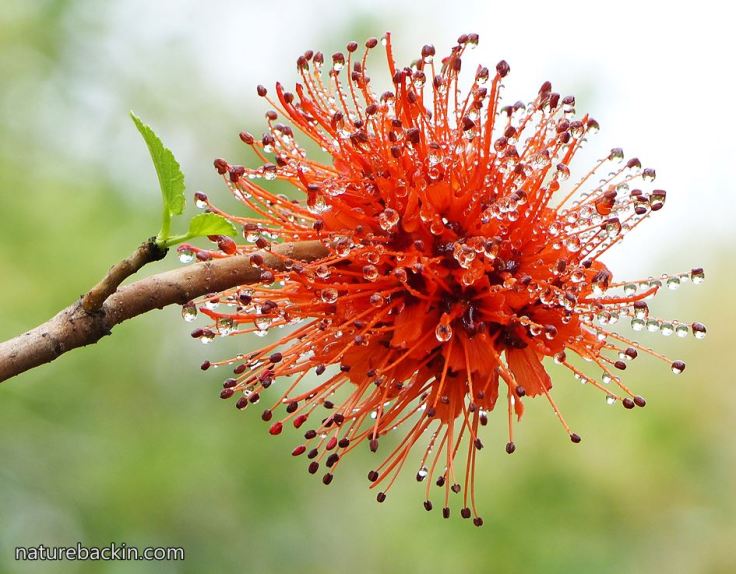
The sutherlandii part of the plant’s name is in honour of Peter Cormack Sutherland (1822-1898). He qualified as a medical doctor in Scotland, but he was also an explorer, naturalist and geologist. He became Surveyor-General in the colony of Natal in 1855 and remained in that post until he retired in 1887. In addition to his geological survey work, and his other varied interests, he collected plant specimens and seeds in the Drakensberg region. Greyia sutherlandii is one of several plants that bear is name. Apparently he was the first person to send specimens of this tree to England. Greyia sutherlandii has been grown in Europe since the 19th century.
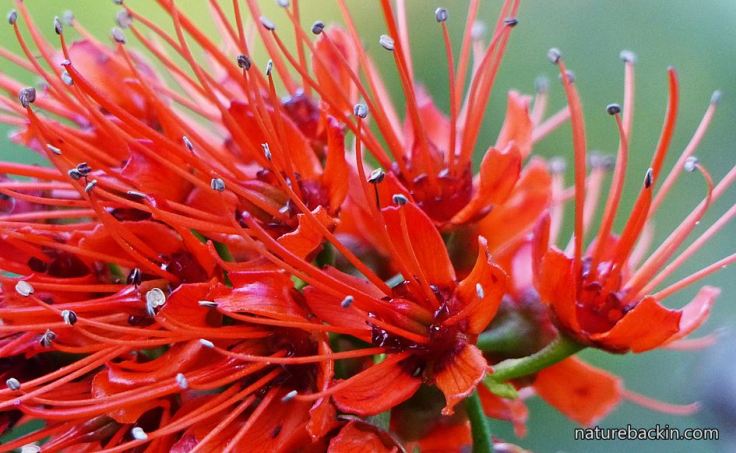
The gorgeous scarlet heads carrying multiple flowers are made even more showy by the long stamens
The wood of this small tree is soft and pinkish and it has been used to make household utensils. Traditionally infusions made from the roots were used to treat nausea. The tree is sometimes grown to form a fence around kraals.
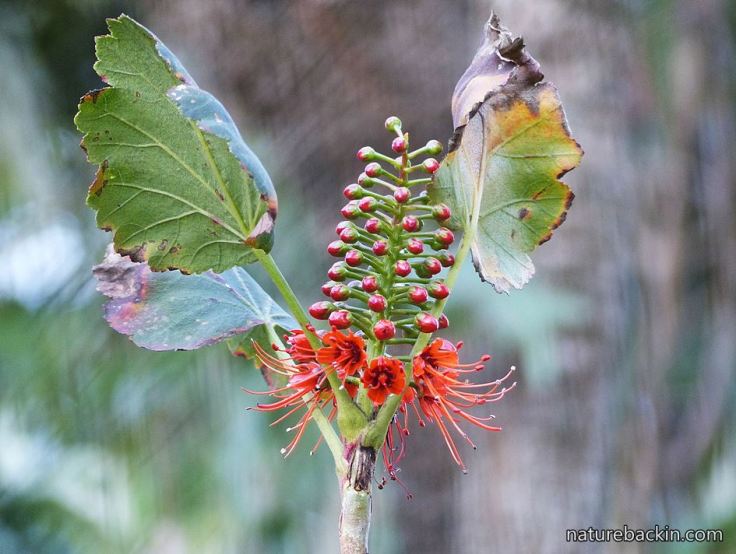
As usual, this season our tree started flowering in winter in late July. Although deciduous, it was still hanging onto its leaves from the previous season

This picture of new leaves was taken last week. Old leaves from last season are still hanging in there
My pleasure in the new spring growth is tinged with anxiety as we await spring rains. Although we have had rain forecast, only 1 millimetre has materialised in our area so far. Last week there was snow on the high Drakensberg mountains, which is ultimately good for the water table, but what remains of our lawn is turning to powder, providing yet another reason to reduce the size of lawns and turn garden lawns into shrubberies and something approximating meadows or wild grasslands.
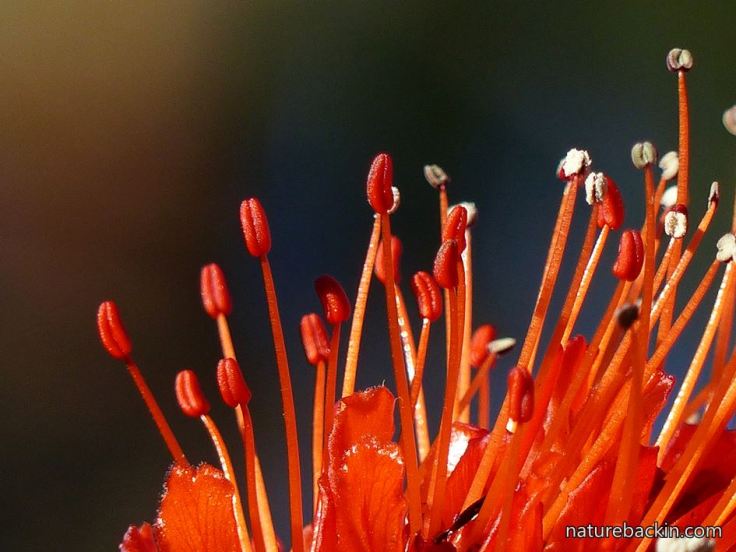
The flowers attract birds and insects seeking nectar
I have not tried it yet, but apparently the Greyia sutherlandii can be grown from slips best propagated in spring. Perhaps a little project starting this spring?
Sources:
Auckland City Libraries. 2010. Sir George Grey. http://georgegrey.org.nz/SirGeorgeGrey.aspx
Nonyane, Frank. 2010. Greyia. National Biodiversity Institute (SANBI). http://pza.sanbi.org/greyia
Plug, C. 2014. Sutherland, Dr Peter Cormac (geology, surveying, plant collection). S2A3 Biographical Database of Southern African Science http://www.s2a3.org.za/bio/Biograph_final.php?serial=2766
Boon, Richard. 2010 (2nd edition). Pooleys Trees of Eastern South Africa: A Complete Guide. Durban: Flora and Fauna Publications Trust
Posted by Carol

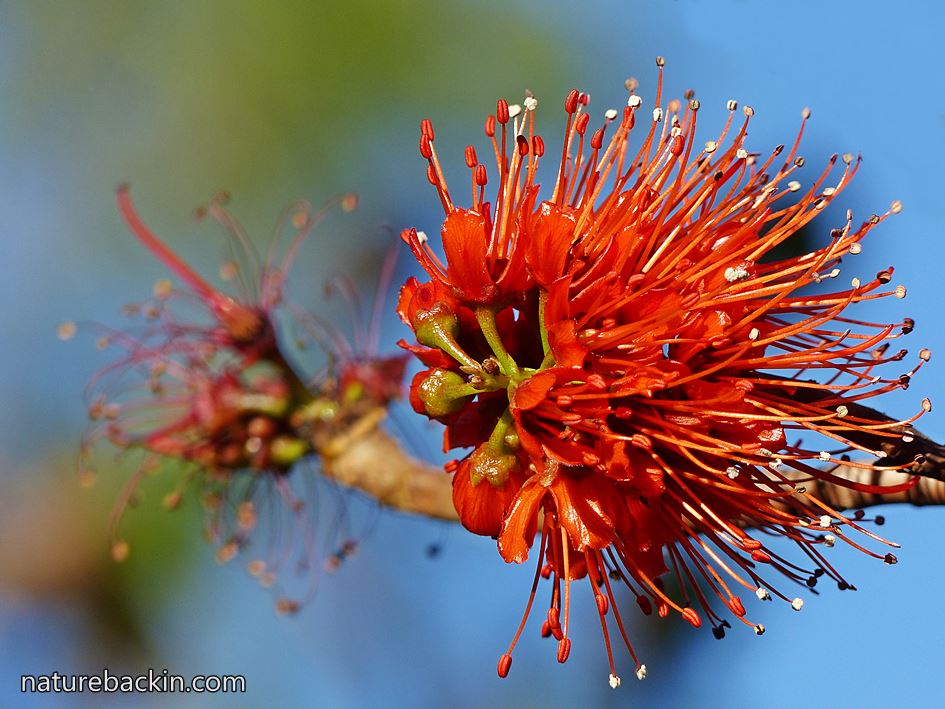





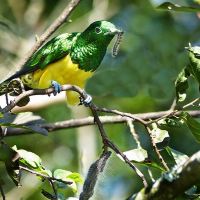
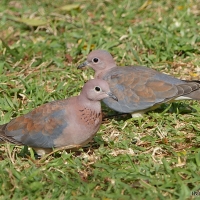
August 27, 2017 at 1:12 pm
Such beautiful pictures and interesting information. I always find photographing red colour difficult but your’s are perfect. The flower with tiny droplets is amaxing.
LikeLiked by 1 person
August 27, 2017 at 4:29 pm
Thanks. I know what you mean about problems photographing red flowers. Some of my photos of this flower tended towards being too orange, so they ended up in the reject file. I am not sure what quality in the light makes this happen.
LikeLiked by 1 person
August 28, 2017 at 6:10 am
You got it right Carol.
LikeLike
August 25, 2017 at 7:56 pm
A beautiful plant, Carol. I love the shot with the water droplets. Hope you get rain soon!
LikeLiked by 1 person
August 26, 2017 at 4:23 am
Thanks so much Eliza. I also like the water droplets. That pic was taken after spring rain last year. Rain is forecast for us late next week so let’s hope it stays on track. It seems so recent that you were posting about spring in your garden!
LikeLike
August 26, 2017 at 5:20 pm
Time does seem to fly. I love that through my southern hemisphere blogging friends, I get not one, but two springs a year!
LikeLiked by 1 person
August 26, 2017 at 6:50 pm
That is a great way to look at it!
LikeLiked by 1 person
August 25, 2017 at 3:47 pm
He y Carol, you qualify as a research fellow
LikeLiked by 1 person
August 26, 2017 at 4:19 am
🎓☺
LikeLike
August 25, 2017 at 1:11 pm
Before we moved to this property the Bottle Brush or the Coral Tree were ”must haves” and although this proviso was forgotten as we desperately tried to find a home before the occupation date arrived on our then house, imagine how thrilled we were discovering the property we eventually bought had both of these glorious plants.
They are both treasures and your post and photos does the Bottle Brush proud!
LikeLiked by 1 person
August 25, 2017 at 1:50 pm
Thanks Ark. They are indeed treasures.
LikeLike
August 25, 2017 at 5:17 am
I love this post for it brings back memories of so many hikes in the Natal Drakensberg many years ago! I too first ‘met’ the Greyia Sutherlandii there and was delighted to find a nearby neighbour here has one growing in her garden. It will be interesting to know if your slip-growing project works for I have not come across it in Eastern Cape nurseries.
LikeLiked by 1 person
August 25, 2017 at 5:43 am
Thanks Anne. Yes the association with hikes in the Berg is enduring and nice that it brings similar memories for you too. I will try slipping it this season. I wonder if your neighbour might be willing to let you take a slip?
LikeLike
August 25, 2017 at 2:30 am
Wow!!! So unique!
LikeLiked by 1 person
August 25, 2017 at 5:38 am
Thanks Roda. Glad you like this plant too ☺
LikeLiked by 1 person
August 24, 2017 at 9:23 pm
What an amazing plant. I initially ‘read’ that first photo as a rather aggressive fish. I now know better!
LikeLiked by 1 person
August 25, 2017 at 5:37 am
Thanks Margaret. After reading your comment now I can also see it as a bristling puffer fish of sorts ☺
LikeLiked by 1 person
August 24, 2017 at 9:15 pm
Nice post.. lots of interesting info..🙋🐦
LikeLiked by 1 person
August 25, 2017 at 5:09 am
Thanks very much Birdlady.
LikeLiked by 1 person